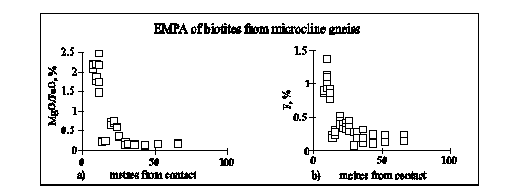
The Eocambrian-Cambrian Bleikvassli Zn-Pb-Ag-(Cu) deposit is closely associated with a microcline gneiss interpreted as the metamorphosed equivalent of an alkaline magmatic rock of syenitic composition. Recent dating of this intrusive yielded a concordant U/Pb zircon age of 481 ±2 Ma whereas the sedimentary exhalative (SEDEX) Bleikvassli massive sulphides are >90 Ma older. In a study aimed at evaluating the metamorphogenic exchange of matter between the microcline gneiss and the massive sulphide deposit during Caledonian metamorphosis, we gathered a profile extending from the contact and 350 metres in to the interior of the gneiss. XRF analysis documented that a 30 metres wide zone in the margin of the gneiss, was depleted in potassium, sodium and calcium whereas iron and magnesium was added to the system, when compared to the interior of the gneiss. Optical spectroscopy and EMPA on rock forming minerals showed that nearly all the Iron and magnesium partitioned in favour of biotite and phengitic mica. Furthermore, it was documented that the concentration of fluorine and magnesium in biotite decreased away from the sulphide deposit and, parallel with this evolution, the concentration of iron increased (Fig, 1a-b). Substitution of F for OH in biotites is inhibited by the iron concentration due to a well documented effect known as Fe-F avoidance (Sanz and Stone, 1979; Munoz, 1984). Due to this phenomena, the increase of the fluorine component of the biotites is solely a function of progressively higher magnesium contents as the massive sulphides are approached. However, EMPA of biotites from the unaltered interior of the gneiss show that they originally had an annitic composition. Decomposition of annitic biotite is, therefore, a prerequisite for the formation of the fluorine and magnesium rich biotites at the margin of the microcline gneiss. According to the study of Nesbitt (1982), iron-rich biotites decomposes in the sulphidation-oxidation halo surrounding massive sulphide deposits because this environment is characterised by high fS2 and low fO2,. Spry and co-workers (1995) recently documented the presence of such a halo around the Bleikvassli massive sulphide deposit.
Because the fluorine concentration of the biotites,
therefore, is an indirect effect of high fS2, which again is a function of the massive sulphides, exploration for fluorine anomalies in metamorphosed terranes, can be used as and aid in the prospecting after metamorphogenic sulphidation-oxidation haloes associated with massive sulphide deposits.
Munoz, J. L. In Micas, reviews in mineralogy (ed. S. W. Bailey). 13, 469-494. Mineralogical Soc. Am. (1984).
Sanz, J. & Stone, W. E. E., Am. Mineral. 64, 119-126 (1979).
Spry, P. G., Rosenberg, J. L., Jacobson, C. E. & Vokes, F. M. In Proc. of the 3rd biennial SGA meeting, Prague/Czech Republic (eds J. Pasava, B. Kribek & K. Zak), 909-912. Balkema. (1995).